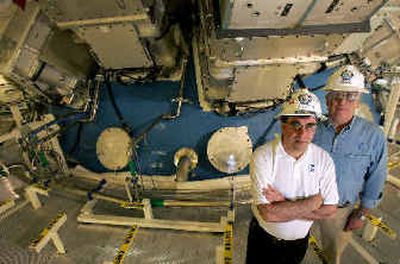‘Super laser’ demands precision

LIVERMORE, Calif. – Ed Moses talks of the “grand challenge” that has consumed him for the past five years, comparing it to trying to hit the strike zone with a baseball from 350 miles away or tossing a dime into a parking meter from 40 miles.
“That’s the precision we have to have,” says Moses, the director of a high-energy physics adventure to produce the world’s most powerful laser – one that scientists hope will create in a laboratory the energy found at the center of the sun.
In a building the size of a football stadium, engineers have assembled the framework for a network of 192 laser beams, each traveling 1,000 feet to converge simultaneously on a target the size of a pencil eraser. The trip will take one-thousandth of a second during which the light’s energy is amplified many billions of times to create a brief laser pulse 1,000 times the electric generating power of the United States.
The goal is to create unimaginable heat – 180 million degrees Farenheit – and intense pressure from all directions on a BB-size hydrogen fuel pellet, compressing it to one-thirtieth of its size.
The result, the scientists hope, will be a fusing of atoms so that more energy is released than is generated by the laser beams, something scientists call fusion ignition. It is what happens when a hydrogen bomb explodes.
Four of the beams have been tested. When completed in 2008, the National Ignition Facility, or NIF, as the laser at the Lawrence Livermore National Laboratories is called, will dwarf many times over any laser to date. It will provide a platform for many experiments in high-energy and high-density physics, from learning more about the planets and stars to advancing the elusive hunt for fusion energy to generate electric power, Moses says.
“You have to think of this like the Hubble,” he says, referring to the space telescope. “It’s a place where you will see things and do things that you couldn’t do anywhere else.”
The government is investing $3.5 billion, possibly several billion dollars more, in NIF to help national security.
If NIF achieves fusion ignition, it will be the first laboratory simulation of the pressures and heat of a nuclear explosion, allowing nuclear weapons scientists to study the performance and readiness of the country’s aging nuclear arsenal without actually detonating a nuclear device.
Underground nuclear testing in the Nevada desert ended in 1992.
The NIF laser “is essential to assessing the potential performance of nuclear weapons,” says Energy Secretary Samuel Bodman. He says the experiments will help determine the effects of aging on warheads and help assure they will work as expected, should they be needed.
There have been other lasers, including a 10-beam Livermore project called Nova. NIF will produce 40 times to 60 times more energy.
“It’s the difference between a car and a jet engine,” Moses says.